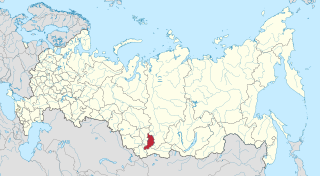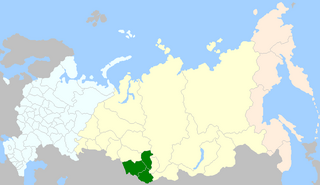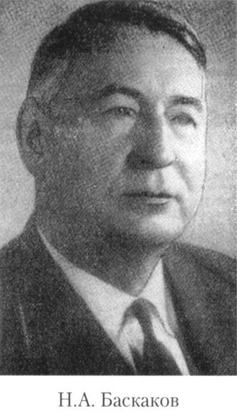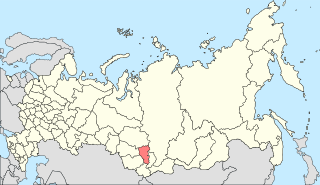
Khakassia, officially the Republic of Khakassia, is a republic of Russia located in southern Siberia. It is situated between Krasnoyarsk Krai to the north and the Altai Republic to the south.

The Tuvans or Tyvans are a Turkic ethnic group indigenous to Siberia who live in Russia (Tuva), Mongolia, and China. They speak Tuvan, a Siberian Turkic language. In Mongolia they are regarded as one of the Uriankhai people groups.

The Altai Republic, also known as Gorno-Altai Republic, and colloquially, and primarily referred to in Russian to distinguish from the neighbouring Altai Krai as the Gornyi Altai, is a republic of Russia located in southern Siberia. The republic borders the Russian federal subjects of Kemerovo Oblast to the north, Khakassia to the northeast, Tuva to the east, Altai Krai to the west, as well it borders three countries: Mongolia to the southeast, China to the south and Kazakhstan to the southwest. It is a part of the Siberian Federal District, and covers an area of 92,903 square kilometers (35,870 sq mi), with a population of 210,924 residents. It is the least-populous republic of Russia and least-populous federal subject in the Siberian Federal District. Gorno-Altaysk is the capital and the largest town of the republic.

Tuva or Tyva, officially the Republic of Tuva, is a republic of Russia. Tuva lies at the geographical center of Asia, in southern Siberia. The republic borders the Altai Republic, Khakassia, Krasnoyarsk Krai, Irkutsk Oblast, and Buryatia in Russia, and shares an international border with Mongolia to the south. Tuva has a population of 336,651. Its capital is the city of Kyzyl.

Burkhanism or Ak Jang is an indigenist new religious movement that flourished among the Altai people of Russia's Altai Republic between 1904 and the 1930s. The Russian Empire was suspicious of the movement's potential to stir up native unrest and perhaps involve outside powers. The Soviet Union ultimately suppressed it for fear of its potential to unify Siberian Turkic peoples under a common nationalism.
The Chelkans are a small group of Turkic Indigenous people of Siberia. They speak the Northern Altai Chelkan language. Those residing in Altai Republic are sometimes grouped together with the Altai ethnic group and those in Kemerovo Oblast are grouped with the Shors; however, they are recognized as a separate ethnic group within the list of Indigenous small-numbered peoples of the North, Siberia and the Far East by ethnographers and the Resolution of the Government of the Russian Federation No. 255 dated March 24, 2000, and Russian Census (2002). But, during the 2010 census, they were again "united" with the Altaians. According to the 2010 census, there were 1,181 Chelkans in Russia.

Teleuts are a Turkic Indigenous people of Siberia living in Kemerovo Oblast, Russia. According to the 2010 census, there were 2,643 Teleuts in Russia. They speak the Southern Altai Teleut language/dialect.

The Kumandins (natively, Kumandy, Kuvandy(g)) are a Turkic Indigenous people of Siberia. They reside mainly in the Altai Krai and Altai Republic of the Russian Federation. They speak the Northern Altai Kumandin language.

Telengits or Telengut are a Turkic ethnic group primarily found in the Altai Republic, Russia. Telengits mainly live in a territory of Kosh-Agach District of the Altai Republic. They are part of a larger cultural group of Southern Altaians which include Altai-Kizhi and Tolos.
The Tubalars are an ethnic subgroup of the Altaians native to the Altai Republic in Russia.

Shors or Shorians are a Turkic ethnic group native to Kemerovo Oblast of Russia. Their self designation is Шор. They were also called Kuznetskie Tatars, Kondoma Tatars, Mras-Su Tatars in some of the documents of the 17th and 18th centuries.

UTC+07:00 is an identifier for a time offset from UTC of +07:00. In ISO 8601 the associated time would be written as 2024-02-26T11:31:58+07:00. It is 7 hours ahead of UTC, meaning that when the time in UTC areas is midnight (00:00), the time in UTC+07:00 areas would be 7:00 in the morning.
Geographically, Siberia includes the Russian Urals, Siberian, and Far Eastern Federal Districts.

The Altai people, also the Altaians, are a Turkic ethnic group of indigenous peoples of Siberia mainly living in the Altai Republic, Russia. Several thousand of the Altaians also live in Mongolia and China but are not officially recognized as a distinct group and listed under the name "Oirats" as a part of the Mongols, as well as in Kazakhstan where they number around 200. For alternative ethnonyms see also Tele, Black Tatar, and Oirats. During the Northern Yuan dynasty, they were ruled in the administrative area known as Telengid Province.

Russia, the largest country in the world, has international land borders with fourteen sovereign states as well as 2 narrow maritime boundaries with the United States and Japan. There are also two breakaway states bordering Russia, namely Abkhazia and South Ossetia. The country has an internationally recognized land border running 22,407 kilometres (13,923 mi) in total, and has the second-longest land border of any country in the world, after China. The borders of the Russian Federation were mostly drawn since 1956, and have remained the same after the dissolution of the Soviet Union. In 2014, Russia annexed Ukraine's Crimean peninsula in a move that remains internationally unrecognized.
Leonid Pavlovich Potapov was a Soviet and Russian ethnographer specializing in the study of peoples of southern Siberia.

Nikolai Aleksandrovich Baskakov was a Soviet Turkologist, linguist, and ethnologist. He created a systematization model of the Turkic language family, and studied Turkic-Russian contacts in the 10-11th centuries CE. During 64 years of scientific work (1930-1994), Baskakov published almost 640 works including 32 books. The main area of Baskakov's scientific interests was linguistics, but he also studied folklore and ethnography of the Turkic peoples, and also was a musician and composer.

South Central Siberia is a geographical region north of the point where Russia, China, Kazakhstan and Mongolia come together.

The Gorno-Altai Autonomous Soviet Socialist Republic was an autonomous republic of the Russian SFSR within the Soviet Union. It was formed on 1 June 1922 as the Oyrot Autonomous Region and became the Gorno-Altai Autonomous Oblast on 7 January 1948. It was upgraded to the level of Autonomous Soviet Socialist Republic on 25 October 1990, and was declared a Soviet Socialist Republic on 3 July 1991, although it was not recognised as one. It became the Altai Republic on 31 March 1992. Its capital was Gorno-Altaysk. Agriculture is the main occupation for most of the inhabitants. Like the modern Altai Republic, the Gorno-Altai ASSR shared its international border with the People's Republic of China.

Grigory Ivanovich Gurkin was a Russian landscape painter, the first professional artist of Altai ethnic origin. He is notable for his Altai mountain landscapes.

















